Let’s be honest; there are many different types of tuna that you might not have heard about. Or, you have known their names but fail to remember the differences between each species.
Whatever your problem might be, this article is a one-stop solution to all of them. In this post, I’ll guide you through the most popular types of tuna on the market with full descriptions of their main traits. Sounds good? Let’s dive right in!
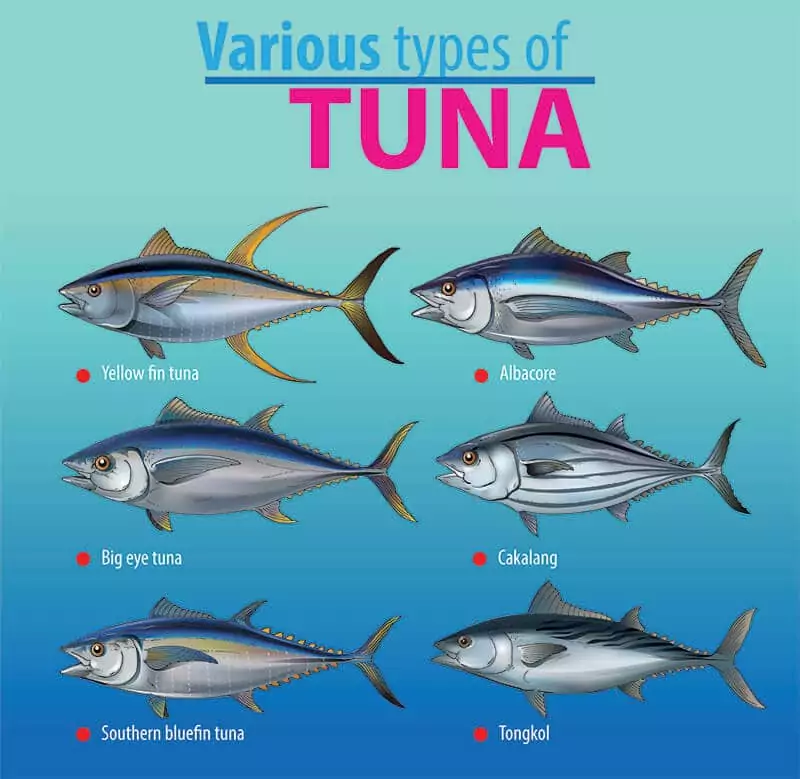
A Quick Overview Of Tuna
Tuna, also known as a tunny, is a species of saltwater fish belonging to the tribe Thunini – a subgroup of the Scombridae (or mackerel) family. The fish has great commercial value and is considered an important food type in many cuisines.
In general, tunas have a dark upper body and a silvery lower half with a glimmering shine. Most of them are sleek, tough, elongated, and streamlined fish. Their body is rounded in the middle and tapers toward a crescent or forked-shaped tail.
Tunas are among the fastest-swimming and edible fish species living in the pelagic zone. They are nimble and active predators that prey on smaller fish, squid, and crustaceans.
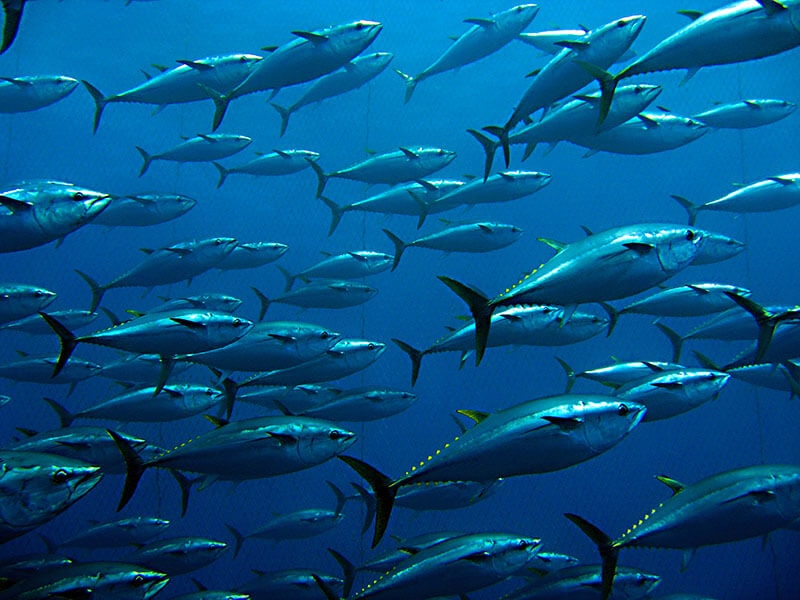
A tuna’s life cycle varies depending on the species. Research has shown that Bluefin tunas might live up to 40 years. However, that figure is only true on paper.
In reality, Pacific and Atlantic Bluefin tunas have an average lifespan of about 15 years, while the Southern Bluefin can easily live up to 30 years. On the other hand, Skipjack tuna only lives for around 8 to 12 years.
Nutritional-wise, these fish are an excellent source of protein and are low in calories and fat. They also provide you with a great amount of omega-3 fats that balance out the omega-6 fatty acids and bad cholesterol, thus reducing the risk of heart disease.
In addition, they’re also rich in iron, vitamin B6, potassium, selenium, and iodine. Eating an adequate amount of tuna might also reduce cancer risk, help with weight loss, and prevent eye diseases. The FDA recommends two to three 4-ounce servings per week for an adult.
Tuna is a well-loved food fish in many parts of the world, and for good reasons. When consumed raw, the fish is tender and oily with a mild and delicate flavor. If you’ve eaten salmon before, you’ll notice a somewhat similar flavor profile.
8 Delectable “True Tuna” Species You Don’t Want To Miss
In the world of tuna, there are generally two large groups: “true tuna” and “other species.” To be classified as “true tunas,” the fish must belong to the genus Thunnus, which consists of Thunnus and Neothunnus.
5 Essential Species Of The Bluefin Group
The Bluefin group, also known as the Thunnus subgenera, is home to the most valued tuna species in the world. Some of them, especially the ones with “bluefin” in their names, are revered as gourmet food and can cost you quite a lot of money to obtain.
1. Albacore Tuna
Scientific Name: Thunnus alalunga
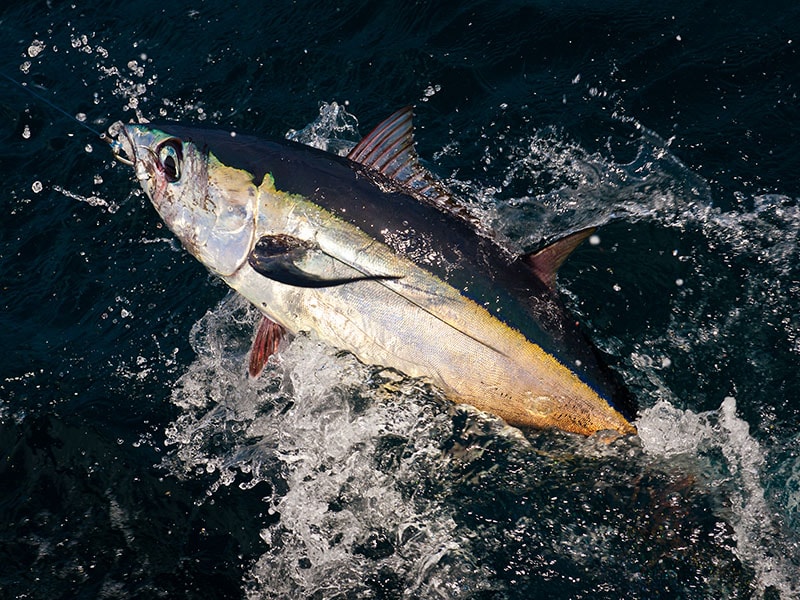
Albacore tuna, also known as longfin tuna or “Chicken of the sea,” as seasoned foodies would call them, are a species in the Perciformes order. They prefer tropical and temperate water and are famous for their distinctively long pectoral fins.
This unique tuna species has an elongated body with deep blue rear and silvery-white abdominal. They can be found mainly in mesopelagic and epipelagic zones in the Atlantic, Mediterranean sea, Indian Oceans, and Pacific.
The Albacore yields white meat and can grow up to 4 feet 7 inches lengthwise. Back in the day, these fish were the backbone of the tuna-canning industry in the United States and take up about 30% of the market today. Trust me; they make for irresistible canned tuna!
The white flesh of Albacore has a relatively mild flavor and can hold together well when cooked, making it a popular choice for grilling. As for its availability, you can easily find canned albacore in common supermarkets or grocery stores.
However, you may want to watch your consumption since the fish is infamous for having a higher mercury level than other tuna species. Generally, it’s best to limit yourself to one Albacore tuna meal a week.
You won’t regret giving this delicious seared albacore tuna recipe a try!
2. Pacific Bluefin Tuna
Scientific Name: Thunnus orientalis
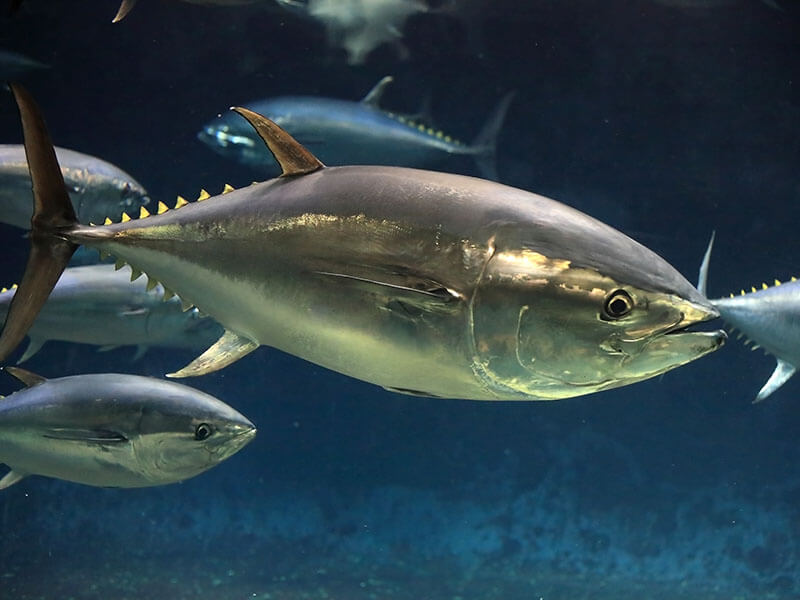
As the name implies, Pacific Bluefin tuna is native to the Pacific Ocean. This species is most prevalent in the northern part of the Earth’s largest and deepest ocean, though it can also be found occasionally in the southern Pacific.
Compared to the previous Albacore tuna, these natural gifts from the Pacific ocean are bigger. An individual can reach up to 9.8 feet in length and 990 pounds in weight. It has a dark blue to black body and silvery lower sides.
Pacific Bluefin tuna used to be grouped with Atlantic Bluefin tuna to create a “combined” species called Northern Bluefin tuna. Both are highly valuable species and can cost you quite a lot, especially if they are sushi or sashimi-graded.
Japan is responsible for 80% of the Pacific and Atlantic bluefin tuna consumption. In “the country of the rising sun”, there’s a tradition that involves auctioning the first batch of Bluefin tuna caught that year. The Japanese believe that these fish will bring good luck.
However, if you want to join in this special event, you’ll need to prepare plenty of money beforehand. In 2019, a 618-pound Pacific bluefin tuna price had reached a record high of 333.6 million yen (about 3.1 million dollars)!
3. Atlantic Bluefin Tuna
Scientific Name: Thunnus thynnus
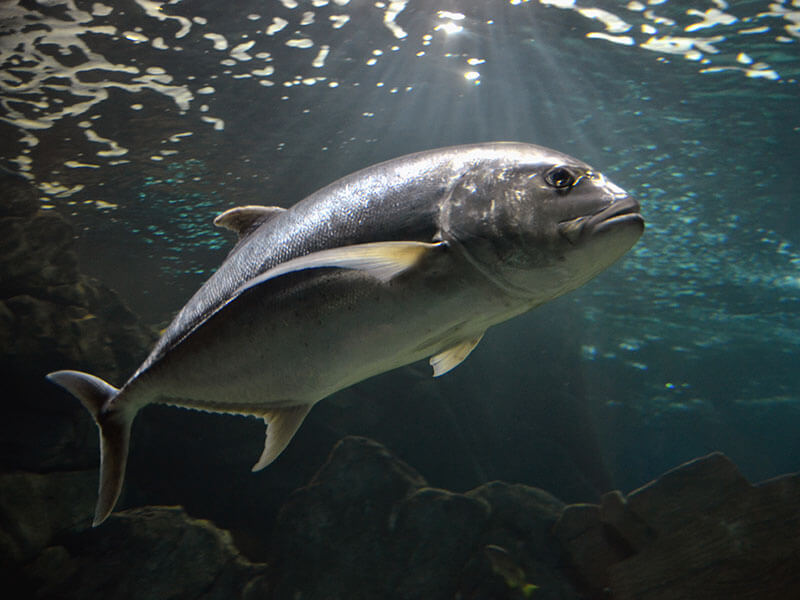
Atlantic Bluefin tuna goes by a couple of different names. When combined with the Pacific Bluefin, it’s called Northern Bluefin tuna. Individuals that exceed 330 pounds are known as Giant Bluefin tuna. But that’s not all! In the past, people used to refer to it as the tunny.
No matter what you call it, there’s no denying that Atlantic Bluefin tuna is one of the most highly prized and sought-after tuna species. So much so that many people consider Bluefin tuna “The Kings of tuna.”
It has a rhomboidal body with a conical head and a large mouth. Besides the classic dark blue and gray color body, it also has radiant yellow caudal finlets.
Like its Pacific cousin, the Atlantic Bluefin is revered in Japan as the go-to fish for many different types of sushi and sashimi. In addition, it has been a prominent big-game species in recreational fishing in the United States, Canada, France, Italy, and Spain since the 1930s.
Due to overfishing, these valuable tuna once suffered a dramatic decline in the stock. Fortunately, its population is now in recovery, thanks to international efforts.
Learn more about the life of Bluefin tuna in under 5 minutes.
4. Southern Bluefin Tuna
Scientific Name: Thunnus maccoyii
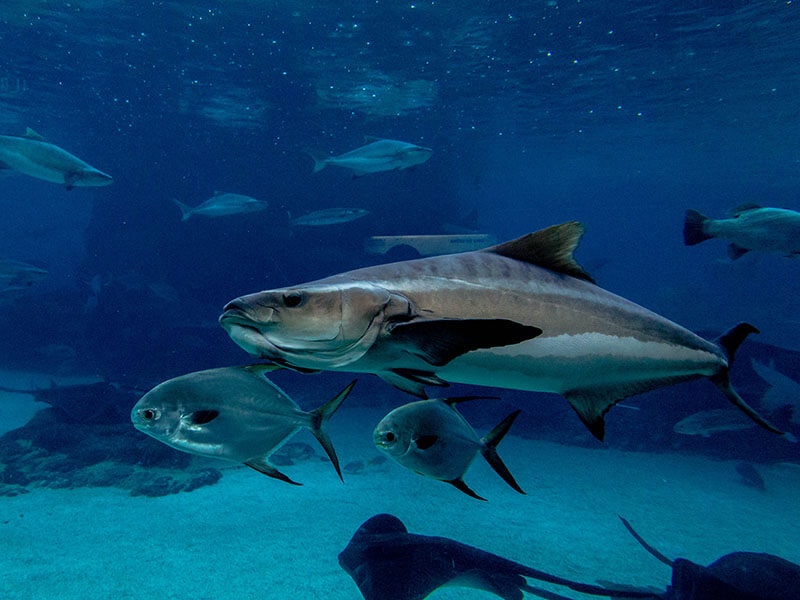
Southern Bluefin tuna is another well-loved species of the Bluefin family. It strives naturally in the Southern Hemisphere waters of every ocean in the world and migrates freely between many regions.
The fish has a relatively impressive size of up to 8 feet 2 inches in length and 570 pounds. In terms of appearance, there isn’t a noticeable difference between the Southern Bluefin and the Northern Bluefin.
Southern Bluefin tuna are widely regarded as gourmet food and, similar to the Northern Bluefin, come at a high price. Japan is by far the largest consumer of this fish, followed by America and China.
If you’re in Japan and want to find the best Southern Bluefin tuna, the Tsukiji fish market in Tokyo is your go-to. Believe it or not, this famous market handles more than 2,400 tons of fish in a day!
Unfortunately, Southern Bluefin tuna is now classified as an Endangered species by the International Union for Conservation of Nature.
5. Bigeye Tuna
Scientific Name: Thunnus obesus
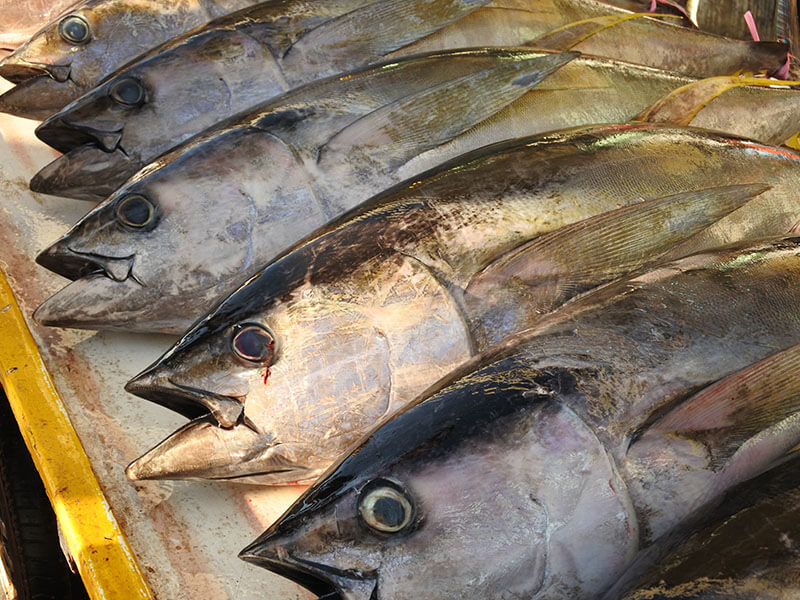
Bigeye tuna is the perfect option If you don’t want to spend a premium price on tuna but still crave an enjoyable meal of fatty sashimi. Although they aren’t exactly “cheap,” these fish will only cost you a quarter of what you need to pay for Bluefin tuna.
Known as “ahi” in Hawaiian culinary culture, Bigeye tuna appear in almost all temperate and tropical oceans, except for the Mediterranean Sea. The Hawaiians also call yellowfin tuna “ahi,” but I’ll save this part for later.
As per its name, the fish has a big head and eyes with long pectoral fins and a streamlined body. A matured Bigeye tuna can reach up to 8 feet in length and more than 400 pounds.
Bigeye tuna is a reasonably priced alternative to its Bluefin counterpart. Despite the gap in price, you’ll still love its firm flesh and delectable flavor. However, it’s not a good idea to overconsume it due to the high mercury level.
As of now, the IUCN has categorized this species as “Vulnerable”. Changes in ocean temperatures also negatively affect its population, especially in the Indian Ocean.
The Yellowfin Group
Compared to the Bluefin group, Yellowfin tunas might not be as fancy and costly. Regardless, they’re still extremely delicious and worth a try!
6. Yellowfin Tuna
Scientific Name: Thunnus albacares
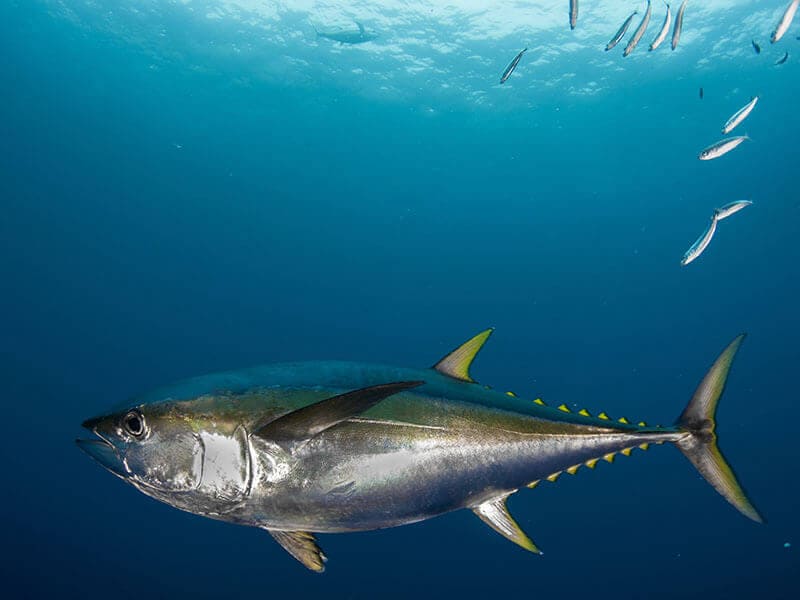
Yellowfin tuna is the other “ahi” in Hawaiian cuisine. Although its scientific name (Thunnus albacares) might cause some confusion with the Albacore tuna, they are two entirely different species.
Generally speaking, Yellowfin tuna is smaller than Bigeye and Bluefin tuna. That is not to say it’s a small fish since it can weigh over 400 pounds.
This species is known for its bright yellow finlets and long dorsal and anal fins. Its body is dark metallic blue and gradually turns silver toward the belly.
When it comes to culinary uses, Yellowfin tuna are quite versatile. The Hawaiians love enjoying them raw, grilled, or lightly seared. Its light pink flesh is quite mild in flavor and is much leaner than the fatty Bluefin or Bigeye tuna.
You can also find these fish in canned or steak forms. Luckily, they’re on the affordable side and are widely available in seafood stores and supermarkets.
If you’re feeling adventurous, try catching some yourself, as Yellowfin tuna is a popular game fish in many parts of the world.
How big can a Yellowfin tuna be? This video is your answer!
7. Longtail Tuna
Scientific Name: Thunnus tonggol

Longtail tuna has another confusing name: Northern Bluefin tuna. The good news is that the latter is only common in Australia. Otherwise, purchasing the right type would be a headache, especially considering the price difference.
This fish lives natively in the tropical waters of the Indo-West Pacific. Despite sharing a similar name, it has a slender body and shorter pectoral fins than the Atlantic and Pacific Bluefins. Longtail tuna usually reach around 57 inches lengthwise and 79 pounds in weight.
Although it has a longer lifespan than other tuna of similar size, it also grows slower. As a result, Longtail tuna is vulnerable to overfishing.
8. Blackfin Tuna
Scientific Name: Thunnus atlanticus

Blackfin tuna is quite small compared to other “true tuna” species.
Last on the “true tuna” list is Blackfin tuna, which is also the smallest of the bunch. They are native to the western Atlantic, spanning from Massachusetts to Brazil. Blackfin tuna has a short life cycle and fast growth.
The little brother in the genus Thunnus only grows to 39 inches in length and 46 pounds in weight at the very max. A black back characterizes these small fish with yellow-ish finlets and sides.
Don’t Neglect These 8 Other Tuna Species
Although they aren’t classified as “true tuna,” the types in this category won’t let your taste buds down! After all, they still belong to the Thunnini tribe, which is known for tasting excellent.
9. Bullet Tuna
Scientific Name: Auxis rochei
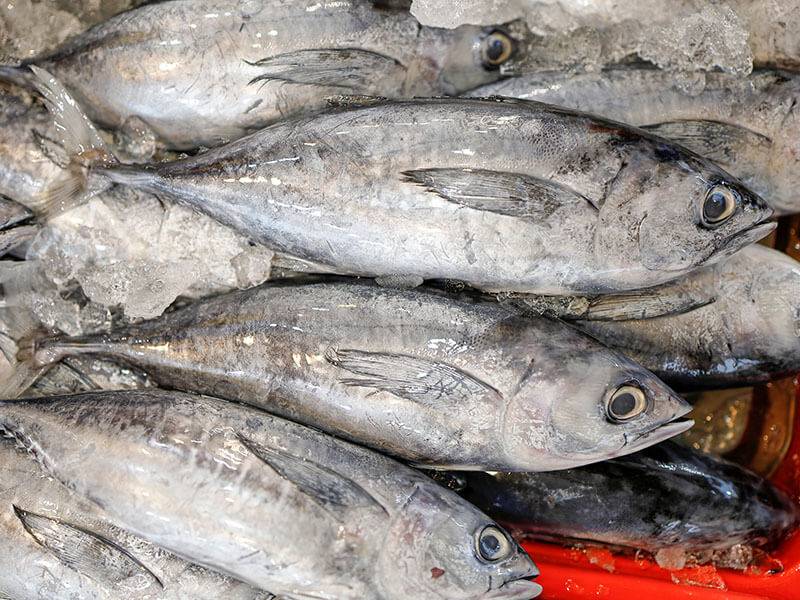
Bullet tuna, sometimes referred to as Bullet mackerel, is a small species in the family Scombridae. They only grow to a maximum length of 20 inches and are relatively slender.
These fish can be found in tropical waters worldwide, especially in the Pacific ocean and the Mediterranean Sea. They’re quite cheap and are commonly sold in fish markets.
In terms of appearance, the Bullet tuna has a blue-black back with dark gray fins. They’re covered with unique zig-zag patterns around the body. The markings are dark on the upper hind part and turn silver below.
10. Mackerel Tuna
Scientific Name: Euthynnus affinis
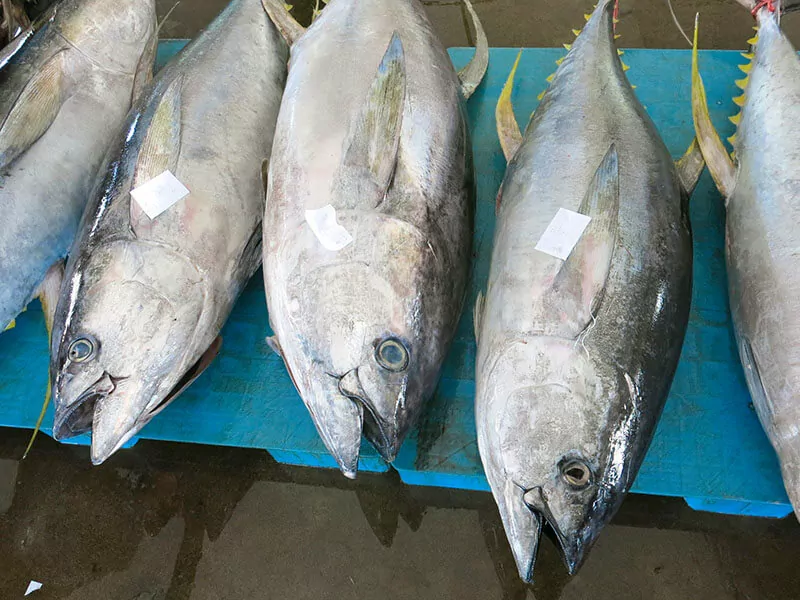
In addition to Mackerel tuna, you might also know these petite fish as little tuna, kawakawa, wavy skipjack tuna, or tongkol. Anyway, they are classified as ray-finned fish and are native to the waters from the Red Sea to French Polynesia.
These Indo-Pacific fish are frequently sold frozen or canned. Plus, people also dry, salt, smoke, or enjoy them fresh. Moreover, anglers usually utilize them as bait.
11. Little Tunny
Scientific Name: Euthynnus alletteratus
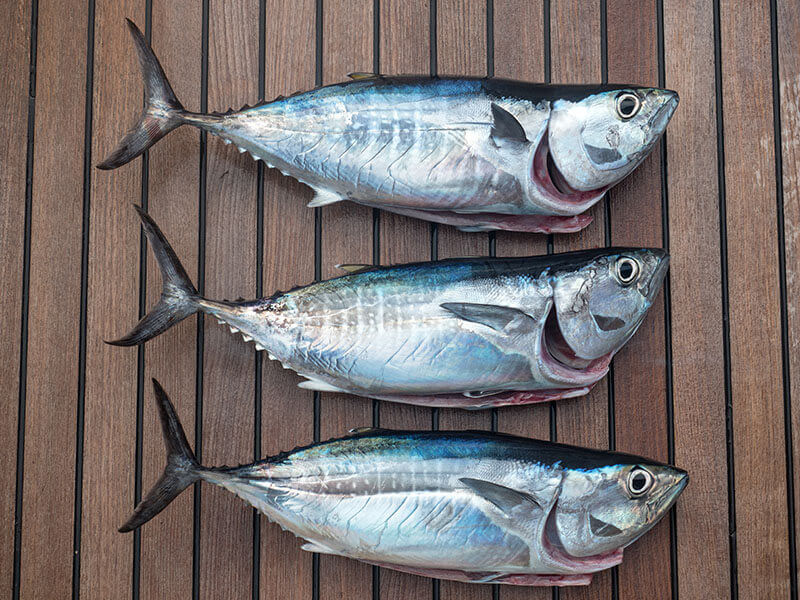
Although Little Tunny isn’t a “true tuna,” it’s actually the most prevalent tuna species in the Atlantic Ocean. The fish appear in tropical and warm temperate areas in both the Atlantic and the Mediterranean seas.
As per their name, these fish are indeed small, weighing only 36 pounds max. People also call them False Albacore, though they resemble the Skipjack tuna more.
You can identify them by the distinct dark spots between their fins and “worm-like” patterns on the back.
Little Tunny has a rather robust and stronger taste than other tuna. For some people, this flavor profile is a bit hard to bear. Thus they think of Little Tunny as a “rough fish.”
However, these small fish are widely loved and available fresh, canned, smoked, dried, or frozen in many regions.
Moreover, fishers use Little Tunny as bait for sharks and larger tuna. These tuna also make for challenging sport fish, thanks to their high swimming speed of 40 miles per hour!
Check out how people catch and cook Little Tunny tunas.
12. Skipjack Tuna
Scientific Name: Katsuwonus pelamis
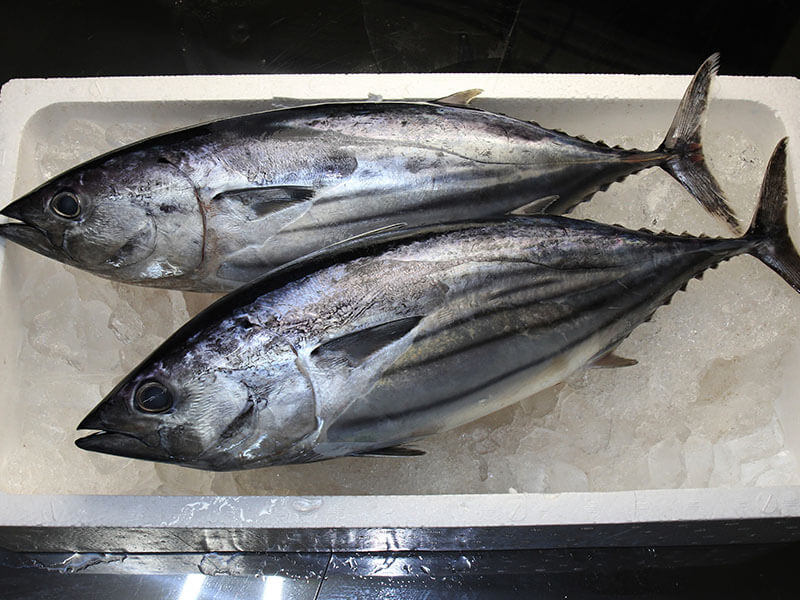
Skipjack tuna is a medium-sized tuna species with many names. You can call it balaya, cakalang, arctic bonito, katsuo, mushmouth, striped tuna, oceanic bonito, or victor fish. The fish spawn in batches and is native to tropical waters globally.
Lengthwise, it might grow up to 2 feet 7 inches and weigh about 76 pounds max. Commercial fishers commonly use Skipjack tuna as bait for marlins.
If you’ve eaten canned tuna before, chances are you’ve tasted Skipjack tuna. Their tender flesh makes them an impeccable choice for canning. Plus, they have a rather short life cycle, meaning that companies don’t have to worry about overfishing.
As a matter of fact, approximately 70% of canned tuna in the United States comes from Skipjack. The remaining 30%, well, you guessed it, belongs to the Albacore tuna.
These bony fish also play an important role in Japanese cuisine, where they’re known as katsuo. Moreover, the Philippines and the Haiwains also enjoy Skipjack tuna immensely.
13. Black Skipjack Tuna
Scientific Name: Euthynnus lineatus

Black Skipjack tuna is native to the eastern tropical waters of the Pacific Ocean. They’re small, bony fish with blue bodies and dark gray or black marks above the pelvic fins.
Unlike its cousin, Black Skipjack is not a species you typically see in the fish markets. In fact, they’re not even on the list of targeted fisheries due to their low meat content. These fish are, literally, skin and bones.
14. Slender Tuna
Scientific Name: Allothunnus fallai
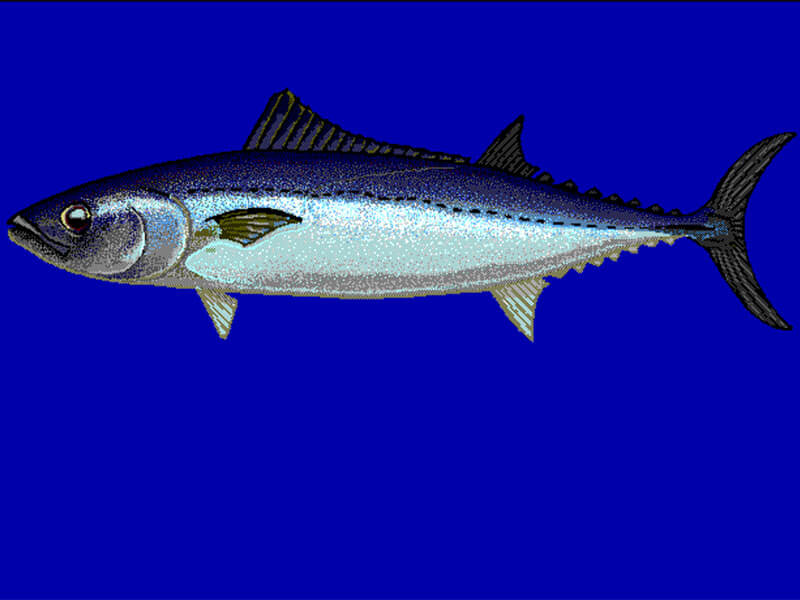
Slender tuna is the only member of the genus Allothunnus. As the name implies, it’s more slender and elongated than other tuna types. It has a blue-black back and silver to gray sides. You can also see some purple on the pelvic and pectoral fins.
This species is moderate in size, with a total length of up to 3.3 feet and a maximum mass of 26 pounds. Interestingly, Slender tuna is not typically a targeted catch in commercial fishing but rather a bycatch product.
You can still enjoy these fish, though, as they’re delicious once cooked. In addition, you’ll occasionally see canned Slender tuna.
15. Dogtooth Tuna
Scientific Name: Gymnosarda unicolor
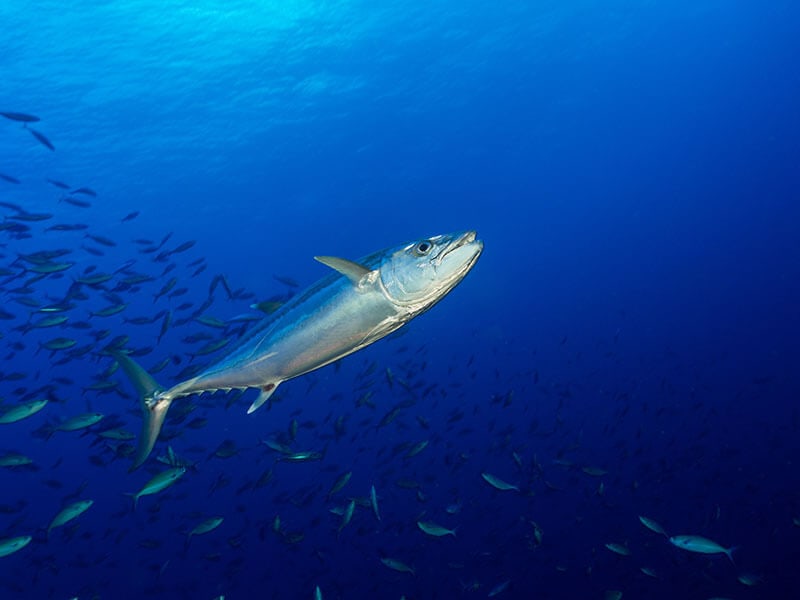
Now, this is one scary-looking fish! Dogtooth tuna, otherwise known as white tuna or Doggy, is a large species living in the tropical oceans of the Indo-Pacific region.
It can reach a maximum length of 8.16 feet and weigh up to 287 pounds. Its gnarly teeth and unique coloration are this aggressive fish’s unique features. There are three colors on its streamlined body, blue-green (back), silver (sides), and whitish (belly).
If you can get past its terrifying appearance, which, honestly, it’s not something you need to care about once the fish is cooked and served, Dogtooth tuna’s taste will impress you. These fish are often sold canned or frozen.
16. Frigate Tuna
Scientific Name: Auxis thazard

Frigate tuna, also called alagaduwa or frigate mackerel, can be found in tropical oceans worldwide. On average, this species weighs about 2 pounds with a total length of 12 inches. However, some individuals might measure around 22 inches and 10 pounds in weight.
Look-wise, it’s quite similar to Bullet tuna, with a deep blue-black back that fades into a somewhat purple shade toward the head. That said, it has shorter corselets under the dorsal fins than that of the Bullet tuna.
This small tuna species has dark and oily flesh, which tends to deteriorate fast. Despite that, it’s still a commercially important fish in many regions and can be utilized as live bait.
Essential Tuna Types For Tuna Steaks And Sushi
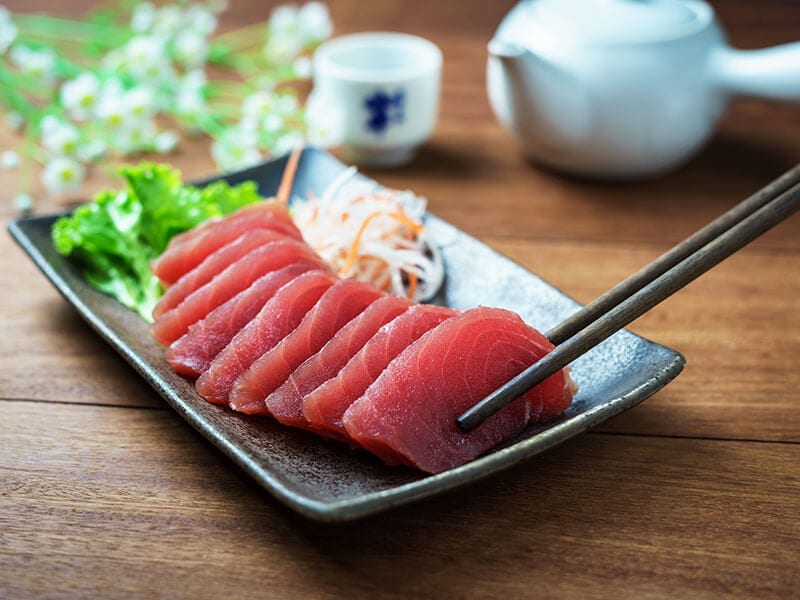
For sushi or sashimi, the most favored picks are Bluefin, Yellowfin, Bigeye, Skipjack, and Albacore tunas. As a general rule, any fish used in these Japanese delicacies must be sashimi or sushi-graded, meaning that they’re safe for raw consumption.
However, there are also some exceptions to this rule, namely in sushi recipes that don’t require raw fish. If you aren’t big on raw tuna, you can check out the list of ingredients to make dragon sushi rolls – a Japanese-American invention.
Tuna steaks, which are cut from the loin part of the fish, are possibly the most beloved tuna cut. They have an appetizing pink or red color and will taste fantastic whether you choose to enjoy them raw or cooked. Plus, there are many tasty side dishes to pair with tuna steaks!
Albacore, Bigeye, Bluefin, and Yellowfin tunas are the most common tuna species used in making tuna steaks.
All You Need To Know About Tuna Grading
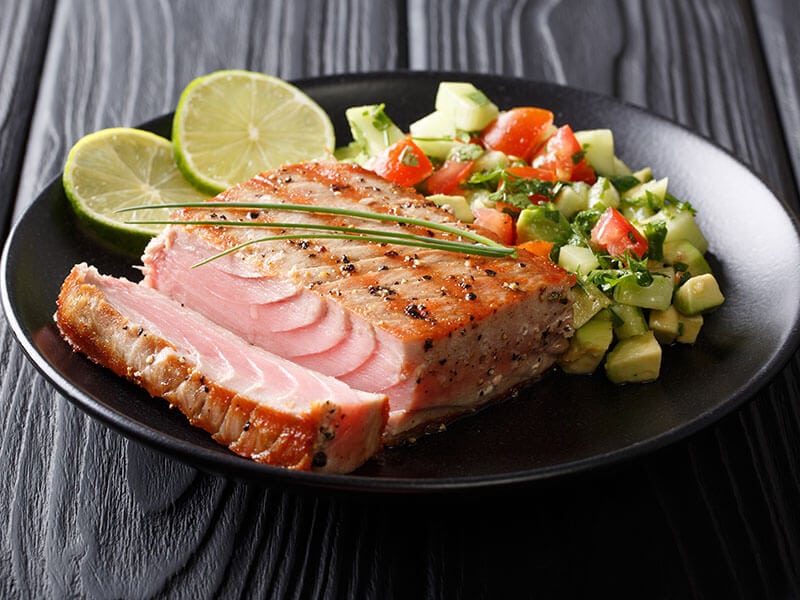
In the sections above, you’ve read about sashimi and sushi-grade tuna, but what exactly does this grading mean? Well, let’s find out more about tuna grading. Generally speaking, there are four common grades for tuna: #1, #2+, #2, and #3.
First-grade tunas are high in fat with a melt-in-the-mouth texture and a shiny, translucent red color. These are the highest-ranking tunas and are often referred to as sashimi or sushi-grade tunas.
#2+ tunas have high fat content but are a bit leaner and less tender than #1 tunas. They’re slightly less shiny and do not possess the transparent red color of the higher-ranking tunas. Still, these fish are also suitable for raw eating.
#2 and #3 tunas are more opaque than red and only contain minimal fat, thus resulting in a firm texture. They aren’t the best suit for raw consumption but still make for delicious grilled dishes.
Fresh Vs. Preserved Tuna – Which One To Choose?

In addition to the many varieties of tuna, you also need to make a decision between fresh and preserved tuna. While everyone loves to enjoy their fish as fresh as possible, it’s not always possible to do so, especially with a big fish like tuna.
If you live near a fish market, where there’s an abundant source of freshly caught tunas coming in and out every day, then, by all means, opt for fresh tunas. Alternatively, you can also buy frozen raw tuna in supermarkets and retailers.
However, preserved tuna is also not a bad choice, especially if you don’t want to deal with the hassle of storing fresh tuna. There are various preserving methods such as smoking, brining, and covering in olive oil.
Level Up Your Meal With These Tuna Recipes!
Now that you’ve learned about the most popular tuna types, I bet that you can’t wait to prepare some simple and quick dishes with this seafood! Well, no more beating around the bush. Let’s get cooking!
Mediterranean Tuna Salad
Mediterranean tuna salad is a perfect dish for both lunch and dinner. Made with fresh, crunchy vegetables, canned tuna, and olive oil or mayonnaise, this recipe will wow all your family members and guests!
Tuna Cakes
How about some easy-to-make yet flavorsome tuna cakes for your dinner? These patties will take you only about 15 minutes at best, and you can even make and freeze them in advance. If you want to cut down on the oil, simply fry them in an air fryer!
Garlic Lemon Tuna Pasta
Nothing can beat some good-old pasta when you need a filling meal. Throw in some tuna and an array of herbs and spices, and you have a mouth-watering dish. You can opt for spaghetti, rotini, or any pasta type of your liking.
What’s Your Favorite Pick?
As much as I want to tell you “the best” type of tuna to choose, there’s no clear answer to that question. Depending on your preference and budget, you might find one tastier or more affordable than another.
In the meantime, don’t be afraid to experiment with different types until you find your favorite! Please click the like button and share it with your loved ones if you find this article helpful. You can also tell me your thoughts in the comments, so feel free to write something!







